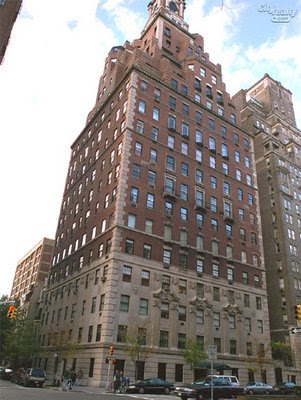C Z GUEST
Flip through the "inspiration" file that every designer keeps, and at some point you will find a picture of C.Z. Guest. Debutante, showgirl (briefly), model (painted nude by Diego Rivera), socialite, gardener, intimate of artists and writers; Guest had the kind of life that seems fiction, and the perfect patrician looks to illustrate it. She wore her designer clothes with thoroughbred elegance, keeping to simple lines, rich fabrics, and soft colors to suit her cool complexion. But perhaps what drew creative types to her most was Guest's down-to-earth personality, exemplified by her recent advice to would-be gardeners visiting her web site, "The most important thing is to enjoy yourself and have a good time."






Comments
The building, which has a four-story limestone base, replaced an apartment house known as the Sunnyside and according to James Trager's book, 'Park Avenue, Street of Dreams,' (Atheneum, 1990), 'was sometimes itself called the Sunnyside.'
Candela is widely considered to have been the country's greatest designer of luxury apartment buildings and he collaborated with many of the city's most famous architectural firms.
Candela's buildings, 'it is said, were the grandest of the decade that was itself the greatest,' wrote Elizabeth Hawes in her book, 'New York, New York, How The Apartment House Transformed The Life Of The City (1869-1930)', published by Henry Holt in 1993.
'He had a respect for privacy and an eye for significant detail. He was a complete thinker. He added duplicate water connections to street mains and multiple switches for ceiling lights as well as beautifully turned staircases and separate wine cellars. More significantly, he designed buildings from the inside out. He placed windows where they received light, balanced a room, or allowed a graceful arrangement of furniture…. Candela also invested unusual energy in the entry hall. In a typical apartment, he made it a full-sized room with rich views into the interior because he thought it was important to greet a visitor with a full sense of a home…. Candela liked puzzles. During the Depression, he took up cryptography, and during World War II, he broke the Japanese code,' Hawes wrote.
Born in Sicily, Candela came to the United States in 1909 and graduated from the Columbia school of architecture in 1915. His other famous buildings include 834 and 960 Fifth Avenue, 720, 740, 770 and 775 Park Avenue, and 19 East 72nd Street, all considered among the most glamorous addresses in the city.
Robert A. M. Stern, Gregory Gilmartin and Thomas Mellins devote considerable attention to Candela in their book, 'New York 1930, Architecture and Urbanism Between The Two World Wars,' Rizzoli, 1987:
'Candela's smaller English Renaissance apartment house at 778 Park Avenue… entered into a remarkably coherent and lively dialogue with his earlier work at 770 Park Avenue; the pair of towered buildings formed a monumental gateway west toward Central Park. At 778 Candela compensated for the regularity of the facades with lavish concentrations of boldly modeled ornament at the corners in the form of quoining and at the limestone base where the second and third-floor windows were grouped together between pilasters supporting fulsome swan's neck pediments to describe a piano nobile.'Brooke,Pat..among others called this home.